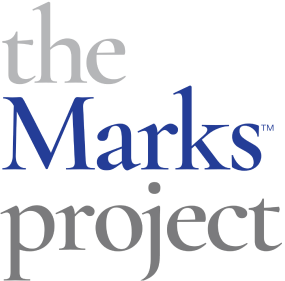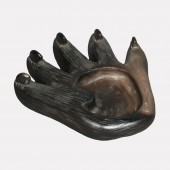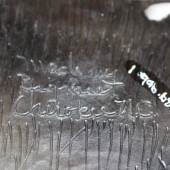![]() Printer version
Printer version
Louise Maney, Louise Bigmeat Maney, and John Henry Maney
1932 Born
2001 Died
EDUCATION
—Family, self-taught
—Haywood Community College, Clyde, North Carolina
PRIMARY WORK EXPERIENCE
—Cherokee Potter
Louise Maney is known for pieces created with her husband John Henry Maney. John Henry threw the pots. Louise did the final shaping and decorating using traditional tools: deer bone knives for incising or carving and stones for polishing; and peach pits, corn cobs, and pattern carved wooden paddles for applying designs. Sharp sticks were used to incise traditional Cherokee weaving and basketry patterns.
Maney, a daughter of Matriarch Charlotte Welch Bigmeat (1887–1959). Charlotte Welch Bigmeat’s signature form is the Indian head pot. Her lasting influence on the quality Cherokee pottery was fixed by her 5 daughters who carried on her clay traditions : Tinie Bigmeat Thompson (1913-1999), Ethel Bigmeat Queen (1916-1942), Elizabeth Bigmeat Jackson (1919-2008), Mabel Bigmeat Swimmer (1925-1991), and Louise Bigmeat Maney (1932-2001).”1 Charlotte and husband, Robert Bigmeat, raised their 5 daughters and son in Wrights Creek in the Painttown section of the Qualla Boundary.2
Maney spent a number of years away from clay while she raised her 7 children and attended Haywood Community College. In 1950, she returned to pottery with her husband, John Henry Maney, as a co-worker. They invested in a potter’s wheel to speed up the process which had previously been done using the coil building method. John Maney then fired them in a 55 gallon metal drum. Color of work was controlled by position of the drum lid. To produce black work, the drum lid was closed. An open lidded drum firing produced work with a natural fired clay color sometimes with flashes of black.
Together the Mandys produced a line of pottery steeped in tradition but they also introduced new forms including footed vessels, cremation urns, vases, bowls with an applied Indian head and seven-sided peace pipes.
Maney’s main influence was Ewi Katalsta, the last conservator of pottery among the Eastern Band of the Cherokees. Maney said this about her training, "I was about six or seven when I started doing pottery. When I was a girl growing up, we used to dig our own clay up here near the Macedonia church on the creek bank. My older brother had a sled and a steer, and he'd haul the clay home. And then we'd lay it out on the ground and spread it out and let it dry." After cleaning the clay, they used an old meat grinder to grind it up. Initially, the pots were either fired in the family cook stove or in pits in the ground.
1 citation: Anna Fariello 9/9/2017
2The Qualla Boundary is referred to in most of the North Caorlina Cherokee potter’s biographies, Anna Fariello reports : “The land owned by today’s Eastern Band of Cherokee Indians comprises a small portion of the original 140,000-square miles of their homeland in the southern Appalachians. The Qualla Boundary is not a reservation, although many call it that. The land that forms the Boundary was not given or assigned by the federal government, instead the remaining Cherokees purchased the tract after federal removal policies drove most of them westward. By the late 1880s, the land was chartered by North Carolina and recognized as belonging to the Eastern Band.Today’s Qualla Boundary is approximately 56,000 acres, located in Jackson and Swain counties. The town of Cherokee functions as he hub of the community and the seat of tribal government.” Citation: Anna Fariello 9/9/2017
PUBLIC COLLECTIONS
Southern Highland Craft Guild, Asheville, North Carolina
BIBLIOGRAPHY
Contemporary Artists and Craftsmen of the Eastern Band of Cherokee Indians: Promotional Exhibitions, 1969-1985. Cherokee, N.C.: Qualla Arts and Crafts Mutual, Inc., 1987.
Duncan, Barbara, Brett H Riggs, C B Rodning, and I Mickel Yantz. Cherokee Pottery: People of One Fire. Tahlequah, OK: Cherokee Heritage Press, 2007.
Wolfe, Robert. 1990. Cherokee BlackPpottery of the Bigmeat Family: Louise Bigmeat Maney, Elizabeth Bigmeat Jackson, Mable Bigmeat Swimmer. Oxford, Ohio: Miami University, 1990.
Citation: "The Marks Project." Last modified October 5, 2019. http://www.themarksproject.org:443/marks/maney





